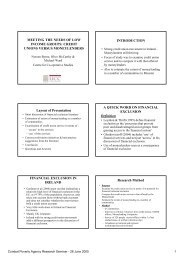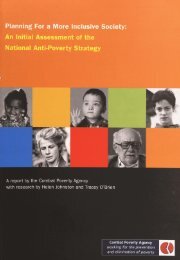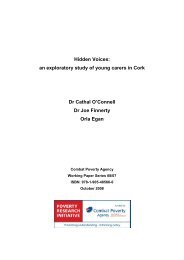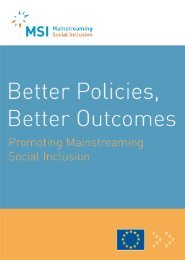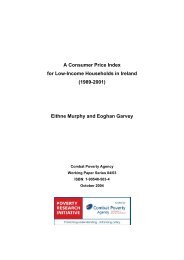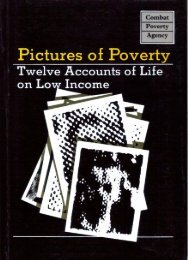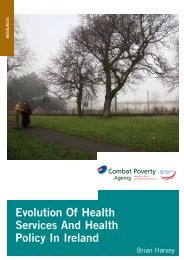The Distribution of Income in Ireland (2000) - Combat Poverty Agency
The Distribution of Income in Ireland (2000) - Combat Poverty Agency
The Distribution of Income in Ireland (2000) - Combat Poverty Agency
- No tags were found...
Create successful ePaper yourself
Turn your PDF publications into a flip-book with our unique Google optimized e-Paper software.
14 <strong>The</strong> <strong>Distribution</strong> <strong>of</strong> <strong>Income</strong> <strong>in</strong> <strong>Ireland</strong>by equivalisation, us<strong>in</strong>g alternative equivalence scales. <strong>The</strong>distributions <strong>of</strong> equivalised household <strong>in</strong>come among householdsand among persons are also compared. Section 3.4 analyses thecomponents <strong>of</strong> change <strong>in</strong> the distribution between 1994 and 1997.Section 3.5 exam<strong>in</strong>es where different types <strong>of</strong> household tend tobe located <strong>in</strong> the distribution. Section 3.6 presents some <strong>in</strong>itialresults for 1998. F<strong>in</strong>ally, Section 3.7 summarises the ma<strong>in</strong> f<strong>in</strong>d<strong>in</strong>gs<strong>of</strong> the chapter.3.2 THE DISTRIBUTION OF DISPOSABLE INCOME AMONGHOUSEHOLDS IN 1994 AND 1997We beg<strong>in</strong> by exam<strong>in</strong><strong>in</strong>g the distribution <strong>of</strong> disposable <strong>in</strong>come -the <strong>in</strong>come concept which has the most direct relevance forability to spend — among households <strong>in</strong> the 1994 and 1997Liv<strong>in</strong>g <strong>in</strong> <strong>Ireland</strong> Surveys (LII). Table 3.1 shows the share <strong>in</strong> total<strong>in</strong>come go<strong>in</strong>g to each decile. We see that <strong>in</strong> each year the bottom10 per cent <strong>of</strong> households had about 2 per cent <strong>of</strong> total <strong>in</strong>come,while the top 10 per cent had about one-quarter <strong>of</strong> thetotal. In broad terms a similar shape for the <strong>in</strong>come distributionis seen <strong>in</strong> other <strong>in</strong>dustrialised countries, and the comparisonwith other EU and OECD countries presented <strong>in</strong> Chapter 5 willhelp to put <strong>Ireland</strong>'s distribution <strong>in</strong> perspective. For the present,though, we concentrate on the Irish pattern and on how ithas been chang<strong>in</strong>g between 1994 and 1997.Two <strong>in</strong>equality measures designed to summarise the degreeto which <strong>in</strong>comes are concentrated are also shown <strong>in</strong> Table 3.1,namely the G<strong>in</strong>i and <strong>The</strong>il measures. As mentioned <strong>in</strong> the previouschapter, different <strong>in</strong>equality measures put most weight on<strong>in</strong>come differences <strong>in</strong> different parts <strong>of</strong> the distribution, and allsuch measures will not always display the same trends, so it isworth look<strong>in</strong>g at more than one. We see from the table thatthese summary measures calculated for disposable <strong>in</strong>comesuggest little difference <strong>in</strong> the level <strong>of</strong> <strong>in</strong>equality between the1994 and 1997 surveys. However, look<strong>in</strong>g at the decile shareswe see that this overall stability masks the fact that there was aslight shift away from both the bottom and the top <strong>of</strong> the distribution,with those <strong>in</strong> the middle ga<strong>in</strong><strong>in</strong>g.<strong>The</strong> <strong>Distribution</strong> <strong>of</strong> <strong>Income</strong> <strong>in</strong> the 1990s 15Table 3.1: Decile Shares and Summary Inequality Measures,Disposable <strong>Income</strong> among Irish Households, 1994and 1997 Liv<strong>in</strong>g- <strong>in</strong> <strong>Ireland</strong> SurveysDecileBottom23456789TopAllG<strong>in</strong>i<strong>The</strong>ilShare <strong>in</strong> Total Disposable<strong>Income</strong> (%)1994 LII2.33.34.66.07.59.111.113.516.526.4100.0Inequality Measure0.3770.2371997 LII2.13.34.56.07.79.511.213.416.525.8100.00.3730.236As well as shares, it is worth stat<strong>in</strong>g the actual <strong>in</strong>come levels requiredto br<strong>in</strong>g one <strong>in</strong>to for example, the top 10 per cent <strong>of</strong> thedistribution, and what constitutes an "average" <strong>in</strong>come. In 1997,the median po<strong>in</strong>t <strong>in</strong> the disposable <strong>in</strong>come distribution amonghouseholds — the po<strong>in</strong>t which splits the distribution exactly <strong>in</strong>two — was about £290 per week or £15,100 per annum. <strong>The</strong> <strong>in</strong>comecut-<strong>of</strong>f for the top decile — the lowest <strong>in</strong>come which wouldbr<strong>in</strong>g a household <strong>in</strong>to the top 10 per cent — was about £630 perweek or £32,700 per year. <strong>The</strong> <strong>in</strong>come below which a householdwould be <strong>in</strong> the bottom 10 per cent, on the other hand, was about£84 per week or £4,400 per year. No account has been taken s<strong>of</strong>ar <strong>of</strong> differences <strong>in</strong> household size and composition, which obviouslyaffect the liv<strong>in</strong>g standard one can reach on these various<strong>in</strong>come levels. It is <strong>in</strong>structive none the less to know what theseabsolute figures are, s<strong>in</strong>ce there may be widespread misper-




